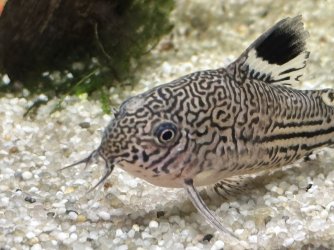Looks to me that she has internal swelling, often called dropsy and it is affecting her swim bladder. The bleeding you are seeing is likely internal bleeding from the swelling. She is a bit bloated.
Problem is that dropsy is a symptom and can have many causes. I have seen it occur with internal bacterial infection (very difficult if not impossible to treat), parasites, internal tumors, and from ruptured internal organs (especially from eggbound females rupturing ovaries, have had a corydoras had this happen in the past. Bloated up really bad, bleeding under the skin and swim bladder struggles with it. Upon death, opened her up and her ovaries had burst and there were eggs everywhere in her body cavity where they shouldn't have been )
)
Unfortunately, many of these cases, there isn't a lot that can be done. This does not mean you can't try.
What I would suggest for this fish, is to remove her from the main tank and into a small tank just for her. Can even be a simple critter keeper type enclosure clipped to the inside of your tank so that the heater from the main tank keeps that warm for her without you needing to run extra equipment.
You need EPSOM salt in this situation, 1 tablespoon per 10 gallons for dosage. You can also choose to soak food in Epsom salt (100% magnesium sulfate btw, no added dyes, oils, or scents! Can buy from department stores or pharmacies in the bath section usually). Epsom salt helps reduce swelling and may give her a chance of recovering. Regular salt will not help her in this case as it won't reduce swelling like magnesium sulfate does.
You may also need to determine the cause of this dropsy, watch for signs of internal parasites in your other fish, test your water parameters and make sure your ammonia and nitrite are 0 and your nitrates are below 20ppm. If all checks out with observations over next while, you might be looking at an internal problem that's not caused by environmental or controllable factors.
If it is internal bacteria, you may notice some bacterial infections spreading to other fish, you will need to do a really good water change to reduce bacteria population, and try to treat with a strong antibiotic such as kanamycin, but even then it may not help with internal bacterial infections unfortunately.
Problem is that dropsy is a symptom and can have many causes. I have seen it occur with internal bacterial infection (very difficult if not impossible to treat), parasites, internal tumors, and from ruptured internal organs (especially from eggbound females rupturing ovaries, have had a corydoras had this happen in the past. Bloated up really bad, bleeding under the skin and swim bladder struggles with it. Upon death, opened her up and her ovaries had burst and there were eggs everywhere in her body cavity where they shouldn't have been
Unfortunately, many of these cases, there isn't a lot that can be done. This does not mean you can't try.
What I would suggest for this fish, is to remove her from the main tank and into a small tank just for her. Can even be a simple critter keeper type enclosure clipped to the inside of your tank so that the heater from the main tank keeps that warm for her without you needing to run extra equipment.
You need EPSOM salt in this situation, 1 tablespoon per 10 gallons for dosage. You can also choose to soak food in Epsom salt (100% magnesium sulfate btw, no added dyes, oils, or scents! Can buy from department stores or pharmacies in the bath section usually). Epsom salt helps reduce swelling and may give her a chance of recovering. Regular salt will not help her in this case as it won't reduce swelling like magnesium sulfate does.
You may also need to determine the cause of this dropsy, watch for signs of internal parasites in your other fish, test your water parameters and make sure your ammonia and nitrite are 0 and your nitrates are below 20ppm. If all checks out with observations over next while, you might be looking at an internal problem that's not caused by environmental or controllable factors.
If it is internal bacteria, you may notice some bacterial infections spreading to other fish, you will need to do a really good water change to reduce bacteria population, and try to treat with a strong antibiotic such as kanamycin, but even then it may not help with internal bacterial infections unfortunately.




